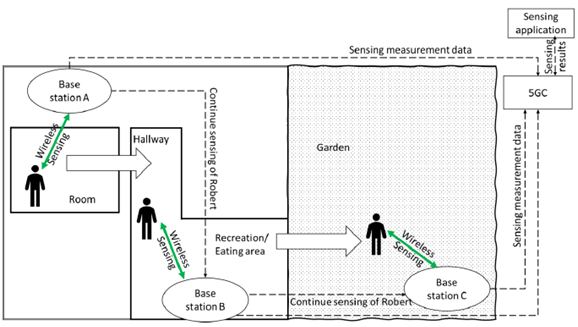Content for TR 22.837 Word version: 19.3.0
0…
4
5…
5.2…
5.3…
5.4…
5.5…
5.6…
5.7…
5.8…
5.9…
5.10…
5.11…
5.12…
5.13…
5.14…
5.15…
5.16…
5.17…
5.18…
5.19…
5.20…
5.21…
5.22…
5.23…
5.24…
5.25…
5.26…
5.27…
5.28…
5.29…
5.30…
5.31…
5.32…
6…
7…
5.18 Use case on service continuity of unobtrusive health monitoring.
5.18.1 Description
5.18.2 Pre-conditions
5.18.3 Service Flows
5.18.4 Post-conditions
5.18.5 Existing features partly or fully covering the use case functionality
5.18.6 Potential New Requirements needed to support the use case
...
...
5.18 Use case on service continuity of unobtrusive health monitoring. p. 54
5.18.1 Description p. 54
An elderly home has installed a new 5G system capable of providing communication and sensing capabilities through the facilities as illustrated in Figure 5.18.1-1. The deployed 5G system includes multiple sensing devices, e.g., base stations, providing connectivity and sensing capabilities. These sensing devices can perform wireless sensing of a target, in this case, health monitoring (e.g. fall/activity detection [34] [35] [36] or wireless sensing of vital signs such as heart rate [38] or breathing rate [37] of one or more persons). Since elderly people move through the facilities, it is important to provide health monitoring independently of the base station used for sensing. The staff of the elderly home really likes this new 5G wireless sensing feature because it is unobtrusive and offers various advantages over the old system that they use with body worn sensors. For example, they don't need to recharge or replace the batteries of body worn sensors anymore and remind people or help people to wear them after they took them off (for example to take a shower). The elderly people themselves also like it more, since the body worn sensors often made them feel uncomfortable, especially during sleep or during hot days. Installing cameras was not seen as a good alternative because of the privacy concerns.
In the provided use case, base stations cooperate with each other to ensure service continuity for sensing of a 'target' user. In this particular scenario, a user, Robert, is considered who moves through the facilities. Robert's health is quite frail and requires continuous monitoring of his health state without interruption. Robert is currently sensed by means of (indoor) base station A located near his room and is moving out of the sensing area of base station A and approaching the sensing area of base station B covering the recreation/eating area and part of the hallway. Base station A and base station B cooperate in such a way that it is ensured that base station B has started wireless sensing of Robert before base station A stops its wireless sensing of Robert. When Robert is in range of both base station A and B, both base stations can cooperate to perform simultaneous wireless sensing. Similarly, when Robert decides to go for a walk to the garden that is covered by Base Station C, the sensing of Robert is seamlessly continued by Base Station C. The 3GPP sensing data is collected and processed by the 5G network (e.g. to detect certain movement patterns) and then sensing results are exposed to a sensing application that is automatically monitoring health anomalies. If a health anomaly is detected (e.g. Robert falls down), an alarm is triggered indicating the health condition as well as the location of the monitored user.

Figure 5.18.1-1: Example of service continuity between Base stations A, B and C.
(⇒ copy of original 3GPP image)
(⇒ copy of original 3GPP image)
5.18.2 Pre-conditions p. 55
- MNO operates a 5GS providing wireless sensing capabilities through a set of base stations installed in the elderly home and its garden, as illustrated in Figure 5.18.1-1.
- Robert has subscribed to the wireless sensing service offered by the 5GS in cooperation with an external application provider. Robert provided some identification information, e.g. which room he resides in, the identity of his mobile phone and/or some physical characteristics (e.g. length). The application provider has no knowledge of the RAN infrastructure operated by the MNO.
5.18.3 Service Flows p. 55
- Robert is currently located in his room in the elderly home. The closest nearby base station, i.e. base station A infers, based on the identification information provided by Robert, that Robert is in his room. Base station A starts wireless sensing of Robert, whereby it sends the 3GPP sensing data to the 5GC for further processing, after which the sensing results are sent to a sensing application to detect health anomalies
- Robert starts moving toward the garden.
- When leaving his room and entering the hallway, the wireless sensing signal conditions of base station B become better than those of base station A.
- The 5G system coordinates the responsibility of sensing Robert from base station A to base station B. During this time, both base station A and B might sense Robert.
- Base station B is used for sensing Robert
- Base station A can stop sensing Robert.
- When leaving the elderly home and entering the garden, Base Station C continues the sensing of Robert.
5.18.4 Post-conditions p. 55
Robert's vital signs are monitored without interruption independently of his location.
5.18.5 Existing features partly or fully covering the use case functionality p. 56
None.
5.18.6 Potential New Requirements needed to support the use case p. 56
[PR 5.18.6.1]
The 5G system shall support continuity of sensing of a target that may move across a sensing area that may be bigger than the coverage area of a single sensing transmitter.
[PR 5.18.6.2]
The 5G system shall support simultaneous wireless sensing of a target by means of multiple sensing devices.
[PR 5.18.6-3]
Subject to operator's policy, the 5G network may provide secure means for the operator to expose information on sensing service availability (e.g., if sensing service is available and the supported KPIs) in a desired sensing service area location to a trusted third-party.